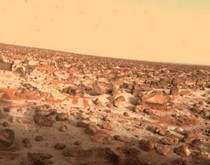'Mars used to have many oceans'
The accumulation of a number of chemical elements in the northern hemisphere of Mars makes American astronomers believe that the ocean once existed on the red planet.

An area in the northern hemisphere of Mars.Photo: daviddarling.info.
After analyzing the data sent by the US Odyssey on Mars orbit to Earth, scientists at the University of Arizona found the presence of several elements in the vast northern hemisphere's of the red planet. It is a low area and may contain a large amount of water to cover almost a third of the Martian surface.
"This evidence opens a whole new perspective on the ocean's hypothesis of the red planet," said James Dohm, an astronomer at the University of Arizona.
The Odyssey is equipped with a gamma ray spectrometer, the device may be due to the distribution density of many chemical elements at a depth of about 30 cm above the surface of the red planet. When cosmic rays include charged particles with high energy in space to hit Mars, the chemical elements at the surface will emit gamma rays. The task of spectrophotometers is to monitor the appearance of gamma rays from the red planet and conduct analysis.
Based on the data provided by the spectrophotometer, James Dohm and colleagues created a map of the northern region of Mars, which displayed the density of potassium, thorium and iron. They found that these elements were distributed higher than the surface above. James explained that the elements on the surface were swept away by water and accumulated in the bottom sediment of an ocean.
Evidence of the existence of an ancient ocean on Mars shows that the red planet once had a warmer, more humid climate today, which is suitable for the development of living organisms. "Many oceans have appeared and disappeared in the flat lands of the northern hemisphere of Mars. They reappear when volcanoes are active. It is possible that each ocean only exists for a few hundred to several thousand years, " concluded James.
He said that because Mars does not have a large moon like our Moon, the ocean on Mars has no tide. Therefore, the coasts on the red planet are unclear and there are characteristic elements of geological structure such as the shoreline on the globe. In addition, after the large ice sheets melted, the water flowed into the lowlands in the northern hemisphere, creating mobile mud blocks covering the coast.
So far, the evidence of the existence of the oceans on Mars has been mainly found in the area between the flat areas of the northern hemisphere and the area surrounding them. Those vestiges indicate the ancient coasts on Mars. Based on the perimeter of those two seas, some scientists speculate that Mars once had two oceans - one 20 times wider and 10 times wider than the Mediterranean Sea. However, they are not considered convincing evidence.
- Did the ocean on Mars get into the rock?
- There is no sea on Mars
- NASA explains the confusing
- Top 10 photos of Mars
- Life may have existed 700 million years on Mars
- NASA has just taken a monstrous photo that looks like a fake about Mars
- Mars used to be 'green planet' like Earth
- Finding shells on Mars
- Close up of the amazing surface on Mars in NASA's latest series
- Close up of the majestic mountains on Mars
- Overview of Mars
- Aliens may have been on Mars 3.8 billion years ago
 Van Allen's belt and evidence that the Apollo 11 mission to the Moon was myth
Van Allen's belt and evidence that the Apollo 11 mission to the Moon was myth The levels of civilization in the universe (Kardashev scale)
The levels of civilization in the universe (Kardashev scale) Today Mars, the sun and the Earth are aligned
Today Mars, the sun and the Earth are aligned The Amazon owner announced a secret plan to build a space base for thousands of people
The Amazon owner announced a secret plan to build a space base for thousands of people